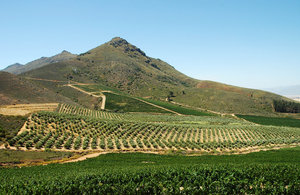| Constantia | Paarl | Stellenbosch | Breede River Valley | Overberg | Klein Karoo |
- Drafted in 1973, the “Wine of Origins” (WO) program legislates how wine regions of South Africa are defined and can appear on wine labels
- The WO is primarily concerned with accuracy in labeling
- The WO doesn’t place any additional regulations on wine regions such as permitted varieties, trellising methods, irrigation and crop yields
- WO system fall under one of four categories, from largest to smallest: Geographical Units, Regions, districts and then finally wards
- Geographical units, regions and districts are largely defined by political boundaries
- Wards are defined mostly by unique terroir characteristics
- Single vineyard designated wine can be produced, provided that the vineyard is registered with the government and all the grapes used in the production of the wine was grown in that vineyard
- The term “estate” no longer qualifies as a designation of geographic origins, wineries can still label “estate wines” provided that all the grapes were grown and the wine vinified and bottled on the same property
- The South African Wine & Spirit Board operates a voluntary program that allows South African wines to be “certified” for quality and accuracy in labeling
- Under this certification process, vintage dated wine must be composed of at least 85% grapes that were harvested that vintage year
- Varietal wines must also be composed of at least 85% of the listed varietal
- Blends, such as a Cabernet Sauvignon and Pinotage blend, can have both varietals listed on the label provided that the two wines were vinified separately
- A wine that has been “co-fermented”, with both grapes crushed and vinified together such as a Shiraz-Viognier, cannot list both varietals
- The use of chaptalization is illegal in South Africa with the country’s warm climate making attaining sufficient sugar and alcohol levels for wine production to be non-problematic
- More often winemakers have problems with low acidity levels in the wine which require some supplementation with additional acids like tartaric acid
Cape port-style wine:
- Long history of fortified wine production known colloquially as “Cape port” (though the term “Port” is protected in the European Union to refer to only the wines from the Douro region of Portugal)
- Made from a variety of grapes, such as Shiraz and Pinotage, as well as Portuguese varieties like Tinta Barroca, Touriga Nacional, Souzão and Fernão Pires
- Cape White port-Can be made from any white grape varieties (such as Chenin blanc, Colombard or Fernão Pires) except for Muscats (required to be aged in wood barrels for at least six months)
- Cape Ruby port-blend of several fruity, full bodied wines that have at least been aged six months in wood for each wine and at least a year total for the entire blend
- Cape Tawny port-blend that has been aged in wood long enough to acquire a tawny color with a smooth, slightly nutty flavor (Blending Ruby and White ports to create Tawny to create Tawny port is prohibited)
- Cape Late Bottled Vintage (LBV) port-composed of grapes harvested in a single vintage that is aged at least two years in oak and three to six years total before being bottled (South Africa wine laws require that the term “Late Bottled Vintage” or “LBV” appear on the wine label along with the vintage and bottling year)
- Cape Vintage port-wine composed of grapes harvested in a single vintage, aged in wood and released with the words “Vintage port” and the vintage year on the label
- Cape Vintage Reserve port-wine produced in a vintage year recognized by the South African wine industry as being of exceptional quality (must be aged for at least one year in oak and sold exclusively in glass wine bottles)
- The words “Vintage Reserve port” and vintage date must appear on the wine label
- South African wine makers also produce “sherry-style” wines produced in a solera system and a unique vin de liqueur made from Muscat known as Jerepigo (or Jerepik)
- Long history of late harvest dessert wines include the modern day Edel Laat-oes wines infected with noble rot (known locally as Edelkeur) containing at least 50 grams of residual sugar per liter
- Wine labeled simply as Laat-oes are from grapes harvested late but not infected with botrytis (must have a residual sugar levels between 10-30 grams per liter)
- Spesiale Laat-oes or “special late harvest” which may imply that some grapes infected with botrytis were used (must have abouve 30 grams of residual sugar)
Sparkling wines:
- Sparkling wines in South Africa are produced with both the Charmat and the traditional “Champagne Method”
- To distinquish South African sparkling wines (and to now comply with European Union regulations protecting the term “Champagne” and champenois), wines made in this traditional bottled fermented method are labeled as Cap Classique
- Traditionally made using Sauvignon blanc and Chenin blanc
- In recent years have seen more of the traditional “Champagne grapes” of Chardonnay and Pinot noir being used
- Red sparkling wine made from Pinotage can also be found


 Masters of Wine
Masters of Wine Wine and Spirits Education Trust
Wine and Spirits Education Trust